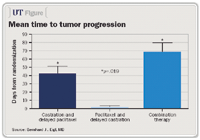Article
ADT-chemo combo cuts time to progression in PCa
Orlando, FL--Recent preclinical evidence now suggests that administering androgen deprivation therapy (ADT) concurrently with paclitaxel (Taxol) is more effective than sequential treatment in androgen-dependent prostate cancer. In a study presented at the 2005 American Society of Clinical Oncology annual meeting, both time to tumor progression and time to sacrifice were significantly improved in mice treated with the combination therapy compared with sequential therapy.

Researchers from The Prostate Centre, Vancouver General Hospital, evenly divided 30 mice bearing Shionogi xenografts into one of three treatment regimens: initial castration and delayed paclitaxel (AA-P), initial paclitaxel and delayed castration (P-AA), or combination therapy. In the sequentially treated mice, the second therapy was administered after disease progression.
Among the mice treated with combination therapy, time to tumor progression was significantly improved compared with those treated with AA-P (mean, 65 days vs. 38 days, p=.019), with a mean of 0 days reported for the P-AA group. Significant improvement in time to sacrifice (median survival days) was also seen in the combination therapy group compared with the AA-P and P-AA groups (median, 79 vs. 67 vs. 43 days, p<.001).
"What surprised us was the lack of response to castration in mice who received chemotherapy prior to castration," said Dr. Eigl, a former research fellow at The Prostate Centre working with Martin Gleave, MD, and colleagues.
Why the attenuated response? According to Dr. Eigl, Shionogi mice usually have a marked response to castration; that is, tumors shrink 90% or more. However, in this study, the tumors did not shrink in mice that were treated with chemotherapy before castration.
To better understand the lack of castration response, the authors conducted an in vitro study in which LNCaP cells were grown in media with or without paclitaxel for varying amounts of time. The authors then looked at the expression of genes bcl-2, bcl-xl, clusterin, and hsp27 in cells exposed to paclitaxel.
"We decided to explore the hypothesis that the reason for this attenuated response is that chemotherapy is causing changes in the tumors that lead to a 'relative' androgen-independent phenotype," explained Dr. Eigl, currently a medical oncologist at the Tom Baker Cancer Centre and clinical assistant professor at the University of Calgary.
Based on quantitative RT-PCR, expression of genes bcl-2, bcl-xl, clusterin, and hsp27 increased between 30% and 60% after 48 hours of exposure to paclitaxel. This suggests that exposure to paclitaxel may induce androgen independence.
The authors also looked at other genes that may be altered by exposure to paclitaxel and found that, in general, genes that were upregulated were anti-apoptotic and proliferative. Downregulated genes were tumor suppressors.
Clinical application Dr. Eigl noted that an important question that remains unanswered is whether the increases in gene expression following exposure to paclitaxel in vitro are transient and are truly indicative of a stress response. If so, these levels may go back to normal, in which case androgen ablation would again work.
In the clinical setting, sequential therapy occurs after a break, ie, when tumor progression is observed.
"It's possible that the break between the two regimens [chemotherapy and androgen ablation] might make a big difference clinically. This question still needs to be addressed," Dr. Eigl said.
Newsletter
Stay current with the latest urology news and practice-changing insights — sign up now for the essential updates every urologist needs.















